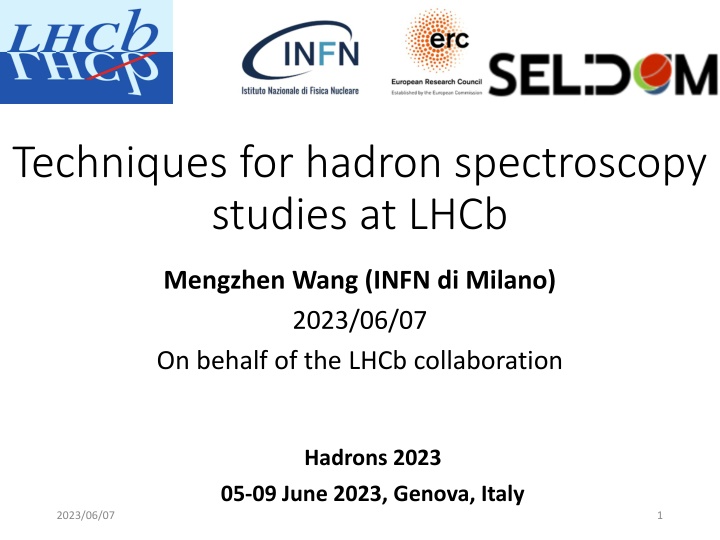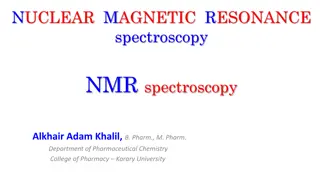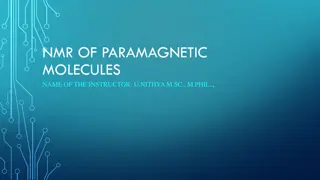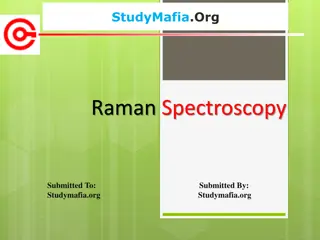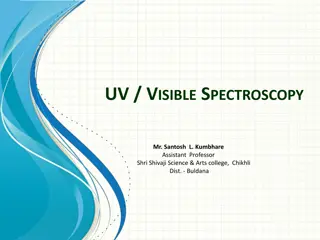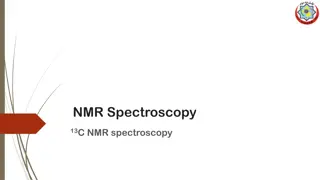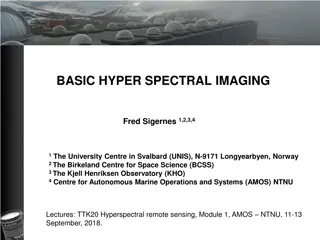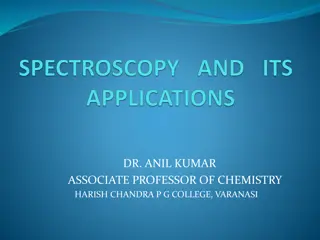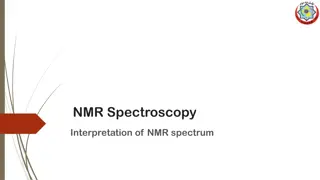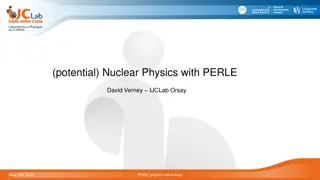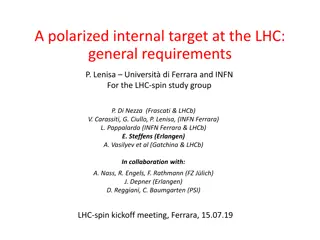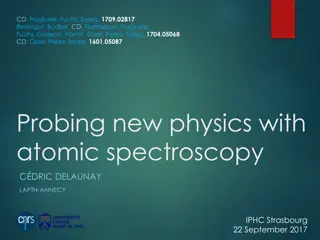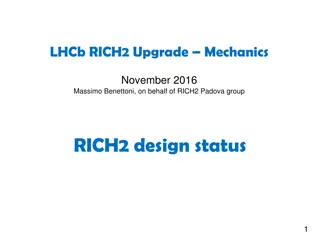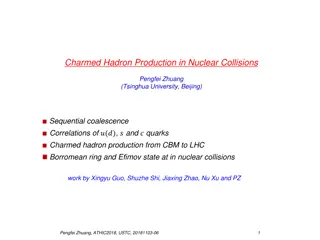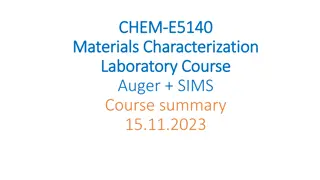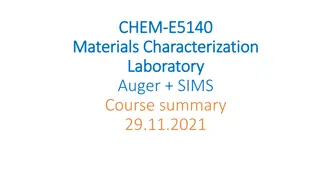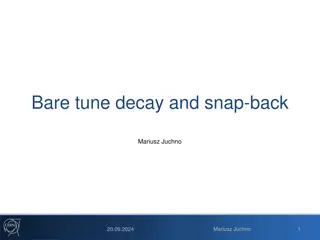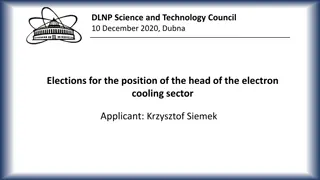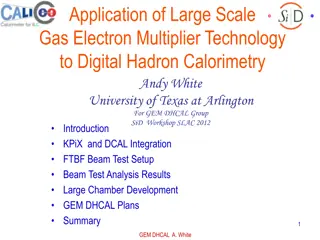Techniques for Hadron Spectroscopy Studies at LHCb
Hadron spectroscopy studies at LHCb focus on searching for new hadrons, measuring their properties like lineshape, lifetime, and decay modes. The LHCb detector is optimized for collecting, reconstructing, and identifying signals to improve knowledge about hadron spectroscopy. Development of data analysis techniques, helicity amplitude formalism, and exploring tetraquark and pentaquark candidates are key topics for recent results. The use of GPUs for faster amplitude fits and the observation of doubly-charm tetraquark candidates are highlighted.
Download Presentation

Please find below an Image/Link to download the presentation.
The content on the website is provided AS IS for your information and personal use only. It may not be sold, licensed, or shared on other websites without obtaining consent from the author.If you encounter any issues during the download, it is possible that the publisher has removed the file from their server.
You are allowed to download the files provided on this website for personal or commercial use, subject to the condition that they are used lawfully. All files are the property of their respective owners.
The content on the website is provided AS IS for your information and personal use only. It may not be sold, licensed, or shared on other websites without obtaining consent from the author.
E N D
Presentation Transcript
Techniques for hadron spectroscopy studies at LHCb Mengzhen Wang (INFN di Milano) 2023/06/07 On behalf of the LHCb collaboration Hadrons 2023 05-09 June 2023, Genova, Italy 2023/06/07 1
?,? spectroscopy at LHCb LHCb: one of the major players of hadron spectroscopy study Search for new hadrons Measure hadron properties (lineshape, lifetime, decay modes ) [link] to the figure 2023/06/07 Hadrons 2023 2
?,? spectroscopy at LHCb Benefit from... LHCb detector optimized for the collection, reconstruction and identification of ?,? signals JINST 3 (2008) S08005, IJMPA 30 (2015) 1530022 Large?,? hadron production cross-section @ LHC High-stat. and good-quality heavy flavor dataset = + Figure from [wiki] Improved knowledge about hadron spectroscopy Data analysis Menu of today: Development of data-analysis techniques benefiting recent LHCb results (Focus on amplitude analysis) 2023/06/07 arXiv:2210.15153, Tetraquark candidate in ??+?? final state Hadrons 2023 3 Nature Communicatitions, 13, 3351 (2022) Observation of doubly-charm tetraquark candidate
Selected topics Development of helicity amplitude formalism Annals Phys. 7 (1959) 404 PRL 115 (2015) 072001 ??4380 ,??(4450) observation Conventional helicity formalism Advances in High Energy Physics (2020) 6674595 Chinese Phys. C 45 (2021) 063103 Phys.Rev.D 95 (2017) 7, 076010 arXiv:2208.03262 + ??? decay amplitude Study of ? New principles for final-state alignment in helicity-based amplitude Science Bulletin 66 (2021) 1278 ?/??? Pentaquark evidence in ? arXiv:2210.10346 Phys. Rev. D 101 (2020) 034033 (4338) Observation of ??? Dalitz-plot decomposition formula Speed up amplitude fits using GPUs arXiv:2301.04899 ? 40000 Evidence of tetraquark candidate ???1 A CUDA + RooFit based fit framework Focus on techniques. For relevant physics results, see the talks by Elisabetta [link] and Bo [link] 2023/06/07 Hadrons 2023 4
Development of helicity-based amplitude formalisms 2023/06/07 Hadrons 2023 5
PRL 115 (2015) 072001 Helicity formalism & ??observation Run 1 ~3fb 1 ?/?? resonance ? [? ????] Conventional resonances ?? 0 ?/??? signals collected in Run1 ~20? ? Clear ?/?? structure seen in Dalitz plot Multi-dimension amplitude analysis to extract properties of ?/?? intermediate states 2023/06/07 Hadrons 2023 6
PRL 115 (2015) 072001 PRL 115 (2015) 072001 supplemental Helicity formalism & ??observation Two decay chains: ? or ?? as intermediate state chain: ?? chain: RBW-based lineshape Wigner-D function to associate initial & final spin states of each two-body decay node Use angles between particle momenta/momentum planes to obtain angular variables 2023/06/07 Hadrons 2023 7
PRL 115 (2015) 072001 PRL 115 (2015) 072001 supplemental Helicity formalism & ??observation Combine two chains to get final matrix element Need a consistent definition of initial & final spin state Rotations in chain chain final spin state Initial spin state Alignment rotation needed ?? chain final spin state Rotations in ?? chain Properly align the definition of final-state spin states in different chains 2023/06/07 Hadrons 2023 8
PRL 115 (2015) 072001 Helicity formalism & ??observation Two ?/?? resonances with significance > 5? minimal quark content [? ????], good candidate for pentaquarks PRL 115 (2015) 072001 PRL 115 (2015) 072001 Run 1 ~3fb 1 Run 1 ~3fb 1 ??(4450) ??(4380) Follow-up analyses: Confirmed in Model-independent analysis Similar structure seen in Cabibbo suppressed ? ??4312 ,??4440 ,??4457 observed in Run1+2 data PRL 117(2016)082002 0 ?/??? PRL 117(2016)082003 PRL 122(2019)222001 2023/06/07 Hadrons 2023 9
Advances in High Energy Physics (2020) 6674595; Chinese Phys. C 45 (2021) 063103 The missing quantum effect ? The conventional helicity formalism (SO3) (SU2) Fully determine Decay angles rotating spin states Rotations in momentum space = PRL 115 (2015) 072001 supplemental Quantum effects missing for baryons ? ? ? ??1,?2 ?? = ? ??1,?2 ?????= ? ???(??+??) (??+ ??) Cannot set a preference between ?? & ??+ ??, ?? & ??+ ?? Arbitrary -1 terms in any single-chain amplitudes: Generate tricky behavior in interference of different chains 2023/06/07 Hadrons 2023 10
Advances in High Energy Physics (2020) 6674595; Chinese Phys. C 45 (2021) 063103 Impact on interference The ,??interference using the formula for ?? observation Impact of missing of the quantum effects consistent with the statement in PRL 115 (2015) 072001 Interference term An unnatural -1 sign impacting half events Total interference vanish Impact on the first ?? analysis: No impact on -only fit quality Reduce the flexibility of + ??model ?? properties (to be) updated in Run1+2 analysis PRL 122(2019)222001: Two-peak nature of ??(4450) observed; Properties of ??(4380) to be updated in future amplitude analysis 2023/06/07 Hadrons 2023 11
Advances in High Energy Physics (2020) 6674595; Chinese Phys. C 45 (2021) 063103 Recover the missing quantum effect Main idea: Origin of the issue is improper alignment of final-state definitions for each decay chain due to arbitrary -1 term Seek for new principles for final-state alignment Conventional method Rely on graphic picture Use angles between particle momenta or momentum planes to define alignment operator 2023/06/07 Hadrons 2023 12
Advances in High Energy Physics (2020) 6674595; Chinese Phys. C 45 (2021) 063103 Recover the missing quantum effect Main idea: Origin of the issue is improper alignment of final-state definitions for each decay chain due to arbitrary -1 term Seek for new principles for final-state alignment Conventional method Rely on graphic picture Use angles between particle momenta or momentum planes to define alignment operator New method Directly write down all rotation/boost operators associating initial/final spin-state frames, using a representation where ? ? + 2? is visible Advances in High Energy Physics (2020) 6674595 Advances in High Energy Physics (2020) 6674595; Chinese Phys. C 45 (2021) 063103 2023/06/07 Hadrons 2023 13
Advances in High Energy Physics (2020) 6674595; Chinese Phys. C 45 (2021) 063103 Recover the missing quantum effect Main idea: Origin of the issue is improper alignment of final-state definitions for each decay chain due to arbitrary -1 term Seek for new principles for final-state alignment Conventional method Rely on graphic picture Use angles between particle momenta or momentum planes to define alignment operator New method Directly write down all rotation/boost operators associating initial/final spin-state frames, using a representation where ? ? + 2? is visible Advances in High Energy Physics (2020) 6674595 New method implemented in ? Advances in High Energy Physics (2020) 6674595; Chinese Phys. C 45 (2021) 063103 + ??? amplitude analysis arXiv:2208.03262 ?/??? amplitude analysis for pentaquark search Science Bulletin 66 (2021) 1278 ? 2023/06/07 Hadrons 2023 14
arXiv:2208.03262 + ?? ?+amplitude analysis ? 2016 data,? = 0.5fb 1; ~400k signals; Helicity-based Am.An.; Measure polarization, resonance fractions and decay parameters Large interference seen between different chains arXiv:2208.03262 arXiv:2208.03262 Large interference between ? 1232++and ? (892) 2022/10/18 LHCb Implications 2022 15
See the talks by Elisabetta [link] and Bo [link] Science Bulletin 66 (2021) 1278 ?/??? amplitude analysis ? Consider as final-state particle, similar spin structure as ? Use same amplitude formalism, with alignment-issue fixed 0 ?/??? decay Science Bulletin 66 (2021) 1278 2022/10/18 LHCb Implications 2022 16
Phys. Rev. D 101 (2020) 034033 Dalitz-plot decomposition (DPD) formula ~ < init. fin.> ~ < init. ???> < ???|fin.> Wigner-D functions Choice of intermediate spin state/frame not unique. Alternative choice: DPD formula DPD formula for 3-body decay 0 123 An arbitrary initial spin frame Same Euler rotation for all decay chains (One Wigner-D function) All momenta (spin-axis of helicity states) aligned to x-z plane; ?1= ? Use conventional helicity formula to write the rest part of amplitude Phys. Rev. D 101 (2020) 034033 Angular variables can be derived using Dalitz-plot variables 2023/06/07 Hadrons 2023 17
See the talks by Elisabetta [link] and Bo [link] arXiv:2210.10346 (4338) Observation of ??? Search for ?/?? and ?/? states in ?+ ?/?? ?+ is spin-zero. 1st Euler rotation is a constant term 2D Dalitz amplitude for 3-body ?+ decay (DPD) 2D amplitude of ?/? ?+? + 2D amplitude of ?? 6D amplitude analysis on ~4500 ?+ ?/?? decays ??? arXiv:2210.10346; supplemental A significance > 10? ~4500 ?+ ??? 2023/06/07 Hadrons 2023 18
Speed up amplitude fits using GPUs 2023/06/07 Hadrons 2023 19
0? decay Study of ?0 ?/??? ???1 4000+observed in ?+ ?/??+? channel Search for its isospin partner in ?0 ?/??? Joint amplitude fit using ?+ ?/??+? and ?0 ?/??? events collected in LHCb Run1+Run2 ? ?? decay ?? ~2k signals ~20k signals PRL 117 (2021) 082001 arXiv:2301.04899 2023/06/07 Hadrons 2023 20
Construction of likelihood function To obtain a log-likelihood value: Loop over all data events in signal region (~20k) ln = (ln 1 ? ??,sig (?) + ? ??,bkg) ? Parameterized using sideband data ??(?)? ? ?? ?norm(?) Signal PDF: ??,sig = Loop over uniform phase-space MC events passing all event selections (400k) ? Norm. factor obtained numerically using MC:?norm= ???(?) Need to calculate matrix element for ~0.4M times Amplitude computations for each data/MC events are independent on each other. Use GPUs to handle the them in parallel 2023/06/07 Hadrons 2023 21
CUDA + RooFit based framework Including all invariant terms in minimization procedure (for example Wigner-D functions) Version 1 GPU type: RTA 3090 2023/06/07 Hadrons 2023 22
Optimization of the framework Optimization of the GPU sector Tools: Nsight Systems (nsys) and Nsight Compute (ncu) by Nivdia zhihong.shen@cern.ch Methods Impact on GPU time calculating one log-likelihood value Malloc once and reuse the memory 8.8ms -> 7.7ms Double -> Float 7.7ms -> 3.7ms Use less registers 3.7ms -> 3.4ms Reduce branch structure 3.4ms -> 2.6ms Re-organize the task of GPU and CPU CPU part start to dominate the time consumption Technical Tricks by chen.chen@cern.ch 2to form NLL GPU organize ? GPU forward NLL to CPU to do minimization (Minuit) 2023/06/07 Hadrons 2023 23
See the talk by Elisabetta [link] arXiv:2301.04899 Performance & achievement ~10mins to run an amplitude fit Even fast enough for toy studies with hundreds of fits needed Physics result ? 0 system (~4?) 4000+ isospin partner 40000 seen in ?/??? Evidence of ???1 Mass, width consistent with ???1 ? 2023/06/07 Hadrons 2023 24
Summary 2023/06/07 Hadrons 2023 25
Summary LHCb has made a great contribution to hadron spectroscopy studies, and is smoothly boosting the field to a new level To persist the ability of handling the ever larger data flow: Improved trigger system, Real-Time Analysis Advanced software tools for Data Processing and Analysis More & more high-quality data is coming. Improved stat. precision Example in this talk: Use GPUs to speed up amplitude analysis Develop & use new phenomenological models in data analysis, minimize relevant systematic uncertainties, to match the ever better stat. precision Stay tuned Thank you for your attention ! Example in this talk: Development of the general formalism for helicity amplitudes 2023/06/07 Hadrons 2023 26
Back up 2023/06/07 Hadrons 2023 27
Phys. Rev. D 101 (2020) 034033 Dalitz-plot decomposition (DPD) formula Split the amplitude into different sectors featuring different aspects of the decays Example: ? 0 ?/??? amplitude Dalitz-variable-dependent amplitude ??+ , dominate the interference behavior Shared by ??, chains chain ?? chain ?/? ?+? decay amplitude shared by two chains A good agreement found with the conventional formalism Chinese Phys. C 45 (2021) 063103 DPD V.S. conventional helicity formula 2023/06/07 Hadrons 2023 28
arXiv:2208.03262 + ?? ?+amplitude analysis ? 2016 data,? = 0.5fb 1; ~400k signals; helicity-based Am.An. (2000) All parameters of amplitude model reported Mass and width of (2000) determined 2022/10/18 LHCb Implications 2022 29
arXiv:2208.03262 + polarization measurement ?? Initial spin structure of ?? Final-state kinematics + Large interference seen between different chains Advances in High Energy Physics (2020) 7463073 Large interference between ? 1232++and ? (892) +polarization from semileptonic ?-decays measured, ?? with 2 different definitions of initial spin axis Model dependency contributes to the largest syst. uncertainty (second term) 2022/10/18 LHCb Implications 2022 30
